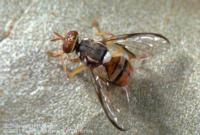Oriental Fruit Fly, recognize it
-
The adult fly is slightly larger than a housefly and is very colorful, with a yellow-striped abdomen and yellowish legs. The white maggots can be found burrowing though fruit. Infested fruit does not always look damaged from the outside but take on a brown, mottled appearance as the maggots feed.

The Danger
These flies attack over 230 different fruit, including apples, avocados, bananas, cucumbers, grapefruit, grapes, lemons, peaches, pears, plums, peppers, tomatoes, and walnuts. The female fly deposits 10 to 100 eggs under the skin of the fruit. Maggots hatch and tunnel through the pulp, turning it into a rotten mass. The Oriental fruit fly can multiply and spread rapidly. Adult flies are very active and can move several miles a day. Females can lay up to 1,500 eggs in their lifetime.Oriental Fruit Fly brochure
Oriental Fruit Fly Quarantine areaUpdate on the regulated areas for Oriental Fruit Fly (October 2013)
New Regulated Areas Established in California for Oriental Fruit Fly
Stephanie D. Stocks, Department of Entomology and Nematology, University of FloridaThe Anaheim area of Orange County and the Cerritos-Artesia area of Los Angeles County in California are under regulation after the detection of oriental fruity fly (OFF) larvae on July 31 as well as subsequent other OFF detections.
So far, 9 larvae and 92 adults have been found in parts of Orange County while 19 adults have been found in parts of Los Angeles County.The last eradication effort for this pest ended in July 2012, but this pest seems to be reintroduced fairly frequently.
from: First Detector Network News
October 2013, Volume 8, Issue 4

